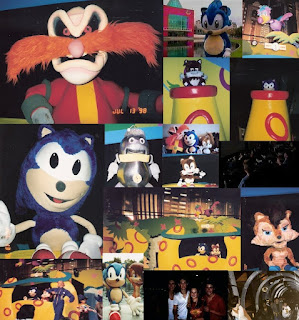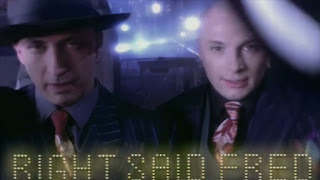Scientifically Accurate: Sonic the Hedgehog
Original Air Date: July 28th, 2014
Cartoon Network's Adult Swim programming block has been around for so long now that it's hard to remember what a risky idea it must have seemed like at the time. Adult centric comedy cartoons airing late at night on cable was a well-established idea by then, with "South Park" being the obvious progenitor, but few channels had successfully copied it. Meanwhile, Cartoon Network's sole foray into older skewing animation was "Space Ghost: Coast to Coast," a deliberately cheap and surreal program that charmed many viewers exactly because it gave such a clear feeling of stoned dudes fucking around. Adult Swim was built on equally cheap and far more surreal shows from the same creative team. Somehow, it not only worked but became a massive success, changing the direction for Cartoon Network as a corporate entity and influencing a lot of other companies to try similar things. Absurdist riffs on forty year old Hanna Barbera shows and Dadaist programs about slacker fast food items with limited animation paved the way for critically acclaimed programs like "The Venture Bros.," Tim Heidecker's anti-comedy empire, and the monstrously popular "Rick and Morty."
And to think, that success was mostly built on the back of reruns of "Family Guy" and "Futurama." That a rival channel has managed to create a cable ratings juggernaut with repeats of their shows must have stung Fox Network execs badly. "The Simpsons" has been premiering new episodes on Sunday nights as long as I can remember. Over the years, Fox has tried to use the iconic sitcom as the anchor for a whole block of funny, edgy cartoons for grown-ups called Animation Domination. It's mostly been made up of "The Simpsons," Seth MacFarlane's various creations, and "Bob's Burgers" for years with a bunch of other shows nobody cares about filling the remaining slots. In 2013, no doubt spurned on by Adult Swim's success, Fox would expand Animation Domination into a late night Saturday block filled with even edgier, weirder cartoons. It was dubbed Animation Domination HD, often abbreviated to ADHD with a snicker, back when that condition was more associated with hyperactive children and not a debilitating mental illness ruining the lives of everyone on the internet, present company included. ADHD debuted with much hype, promoting itself as an equally cutting edge but less cynical alternative to Adult Swim. The block was spearheaded by former William Streets creators, this declaration striking me as a somewhat bitter potshot at their previous employers. ADHD wouldn't only be a TV block either but had a big budget YouTube channel too, that also received a prominent advertising push.
Like most of the desperate shit Fox has tried over the years, Animation Domination HD was a commercial failure. While an adaptation of meme-tastic web comic "Axe Cop" received some minor acclaim, the rest of ADHD's programming landed with a wet thud. A year later, Fox had already given up on the Saturday night block and shuffled any lingering shows off to obscure sister network FXX. All of the ADHD shows would go in the dumper with the dozens of other failed Fox originals. The YouTube channel, however, would be a little more successful. Made up of little shorts and music videos that aired as interstitials on Saturday nights, ADHD would limp on as a modestly successful YouTube brand until 2016, outliving the TV block by almost three years. The biggest hit on the channel was a reoccurring series called "Scientifically Accurate," in which the theme songs of old cartoon shows and the like would be rewritten to include verified biological facts about the animals or subject matters of these shows. In other words: The "Scientifically Accurate" shorts were parodies of old theme songs that any Gen-Xer or Millennial would recognize, that included a lot of gross-out humor and crude factoids about animal genitalia. The most popular installment spoofed "DuckTales" and focused on the horrifying sex lives and organ shapes of Scrooge McDuck's real life counterparts.
Being a well known piece of "Hey, remember that thing?!" nineties kids nostalgia, it was probably only a matter of time before ADHD mocked the "Sonic the Hedgehog" franchise. In 2014, Sega was only just beginning to redefine their star series after years of notorious flops, so the blue hedgehog was still an easy target. The inevitable "Scientifically Accurate: Sonic the Hedgehog" short released in July of 2014. Though set to the melody of the "SatAM" theme song, the video mostly parodies the classic video games. It contrasts the cutesy aesthetic of the "Sonic" series with semi-realistic takes on the characters and – as you might have guessed, from the juvenile comedy approach of the entire series – a prominent focus on poop and gore. It includes an entire verse about anointing, mentions filial cannibalism, and concludes by describing the echidna's unique four-headed penis.
One can definitely argue about the value of gross-out humor such as this. The entire joke of the "Scientifically Accurate" series is contrasting the cute, innocent, defanged visuals and melodies of retro cartoons with the grotesque realities of science and biology. No, a hedgehog and a fox would not be friends in real life. A fox would eat a hedgehog. Yes, real animals get sick, die, poop, sometimes do weird stuff with that poop, have unusual mating habits or equipment, and occasionally freak the fuck out and eat their own babies for seemingly no reason. Pointing out that the natural world is freaky as shit when compared to the Disney-ified version of wildlife we all grew up with is, I guess, as valid a joke as any. The "Scientifically Accurate" series – and, indeed, most of ADHD's YouTube offerings – relief upon the humor of saying something crude, gross, or weird to get an easy laugh out of people. Some have suggested that a fixation on this style of comedy might be one of the main things that keeps American "adult" animation from reaching the same creative heights as cartoons from other countries. When combined with eighties and nineties nostalgia, another thing the internet is obsessed with, you can clearly see how these animated shorts were designed to go viral. Especially in the slightly edgier version of the internet that existed fourteen years ago.
In theory, I actually have no problem with pee-pee poo-poo jokes, a liberal use of fucking swearing, or a fixation on bizarre sexual practices. I mean, have you read this blog? It's kind of one of the main things I do. At the same time, simply throwing a pile of dookie on-screen or drawing a big boner on Raphael is not a fool-proof technique to make me laugh. There's a reason they say comedy is all in timing. A well orchestrated, perfectly paced deployment of gosh darn profanity or some eyebrow wiggling naughtiness is different than merely screaming the word "Penis!" to the heavens. "Scientifically Accurate Sonic the Hedgehog" obviously falls more on the latter side of things than the former. However, I'll admit, this cartoon does make me reliably chuckle. The cartoon depiction of Sonic as both a semi-realistic hedgehog that is still blue and runs fast is a decent gag. Watching him then pop out perfectly shaped little curls of feces while running along a colorful half-pike or making a ungry look at his own offspring is mildly amusing. Similarly, showing a quasi-realistic Knuckles fail to do the things we associate with Knuckles is a decent gag. It's not high-brow humor or anything, obviously. By the standards of a three minute internet gag video, I feel I get the appropriate amount of frivolity out of it.
The fact that such a ribald approach is being taken to the "Sonic the Hedgehog" cast certainly has some novelty. I'm not used to seeing this particular series being referenced by relatively mainstream comedy writers such as these. When that does happen, it's usually a very surface-level reading of the series. "Scientifically Accurate Sonic" has some of that, in terms of pulling most of its imagery from the original Genesis games. However, there are signs here that this was made by people with a slightly deeper knowledge of the franchise. First off, that the novelty is taken from the "SatAM" theme is a big indicator. You don't see that cartoon referenced much outside of pre-existing niches of the fandom, this animation going so far as to spoof specific moments from the "SatAM" intro. Such as Sonic speeding through a tunnel of trees at the very beginning or the title being accompanied by a swirl of spotlights. (In this case, originating out of Knuckles' freakishly four-headed dick hole. Again, because that's the kind of cartoon this is.)
Moreover, there's a verse here that talks about how "Sonic's got a lot of pals." In a quick montage, we see Scientifically Accurate-ified versions of Blaze, Rouge, Cream and... Flying Frog! Now, I have no doubt about the process that led to this extremely obscure character exclusive to the Archie "Sonic" comics popping up in this cartoon. The next line talks about how "foxes eat hedgehogs," a joke the writers of this cartoon with the premise of displaying real facts about the animals from the "Sonic" series obviously had to make. They needed a rhyme that fit and probably simply Googled "Sonic the Hedgehog frog character" in order to find such an example. That certainly strikes me as far more likely than the people behind this thing being passionate fans of a regularly overlooked comic book. If that was the case, the "Scientifically Accurate" writers would know that Flying Frog is not a pal of Sonic's but rather an enemy. Not an especially prominent enemy either but one with a smattering of appearances across the comic's twenty year history that had actually been written out of continuity by the time this cartoon debuted on YouTube.
Nevertheless, a D-lister as D-list-y as Flying Frog showing up alongside well known members of the "Sonic" supporting cast, made by people totally outside of the fandom and official Sega-approved channels, makes this stupid joke cartoon highly notable to me. I recalled when it debuted, watching it and being so stunned at what I saw that I had to backtrack and rewatch that moment a few times to be sure of it. This is as close as we've gotten to, like, Julie-Su showing up on "Robot Chicken" or something. I definitely recall seeing comments under the video baffled as to who the hell this frog guy is, clearly made by inferior plebeians on a less deeply autistic level of nerdom than me. This is the only time I know of when an Archie "Sonic" exclusive character has appeared in some other media, meaning this is the sole time some other person has nodded at this dumb thing I've been obsessed with my whole life. Emotions like this is why I liked "I Saw the TV Glow" so much while also being a cis man.
Is this, in fact, the entire reason I felt the need to write so many words about a gross, perhaps mildly offensive, cartoon mocking the "Sonic" franchise that I doubt many other people have thought about in the last decade and a half, connected to an obscure flop of a programming block that probably made less of an impact on the wider culture than the average rerun of "King of the Hill" that aired the same night? Uhhhh... I don't wanna talk about it. Anyway, I'm sure there are other parodies of "Sonic" from sketch comedy shows of the same notability as this particular one. I probably won't write about any of those, unless they randomly include a reference to Sleuth Doggy Dawg or someone like that. As for "Scientifically Accurate: Sonic the Hedgehog," I think about it at least once a month and also it's mildly funny. [7/10]


































